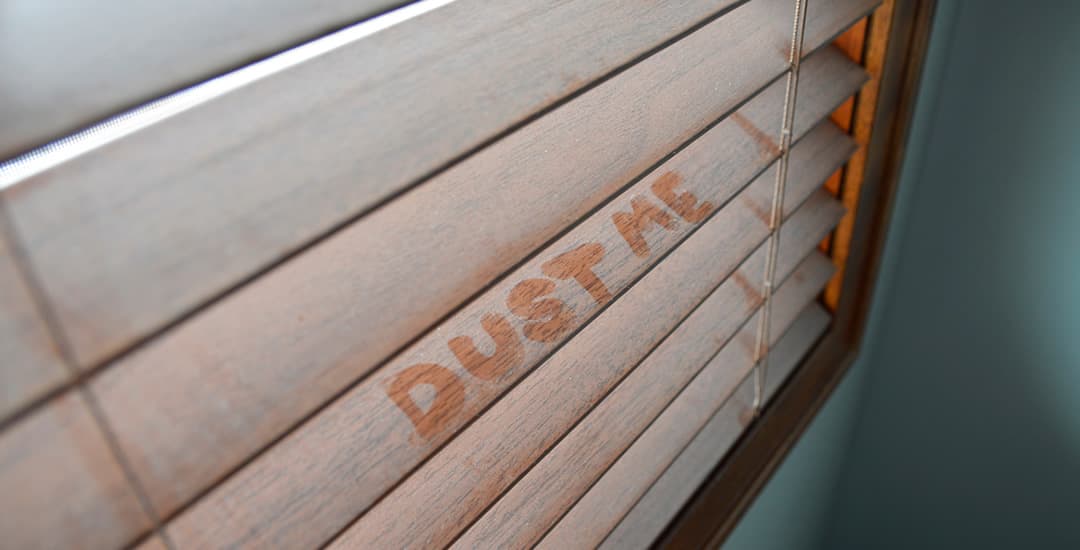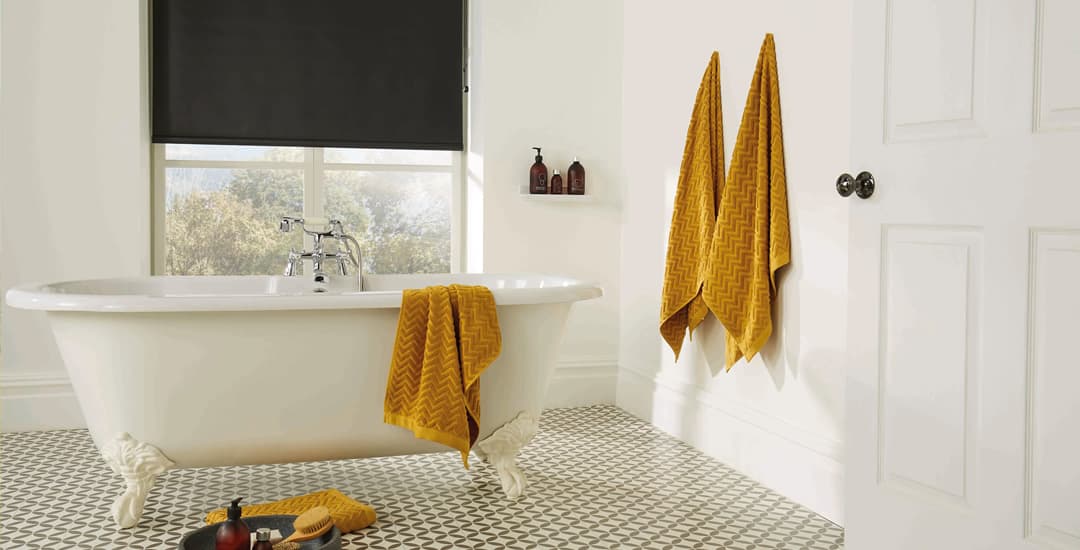
What are the best blinds for dust? Assuming you mean “what blinds don’t collect dust” rather than “which blinds are best for cultivating my own dust colony,” then you’ll be wanting blinds that hang vertically rather than having horizontal surfaces that play host to the floofs. This means that vertical blinds and roller blinds are the best blinds for dust-avoidance.
This blog post will list the best blinds for dust right through to the worst, tell you what blinds don’t collect dust as badly as others and why, and share some tips on how to stop dust from sticking to blinds in the first place.
What blinds don’t collect dust?
One thing to note from the get-go is that except for roller blinds the headrail of all other types of blinds is a horizontal surface that will collect dust over time.
Also, because the headrail is high up, usually above head height, we tend to forget about it or not notice it when dusting in general, which means that they can develop quite the fur coat over time.
This happens to a lesser extent to blinds fitted inside of the window recess with the top of the window frame serving as a kind of “lid” on the headrail than it does to blinds fitted over the window recess. However, this does also mean that getting between the headrail and top of the window frame to dust those inside of a recess is a bit more challenging.
Another point to note is that there is no such thing as a blind that does not collect dust at all; hydrophobic materials are totally a thing, but dustrophobic ones, not so much.
What are the best blinds for dust (if you’re not a fan of dusting)?
The blinds that collect the least dust are blinds that hang vertically, rather than those comprised of one or many horizontal parts.
This means that sheer/flat/one-piece fabrics that hang, such as roller blinds, day and night blinds, and vertical blinds, are best for not collecting dust in the first place.
What blinds are easiest to keep clean?
Regardless of how often or how rarely you clean them, some types of blinds are easier to keep clean or to get clean than others, for a few of reasons.
Blinds that are simple in construction (so not having lots of individual and potentially, fiddly or narrow parts to get to), those made of one sheet or strip of fabric, and those that are waterproof are the type of blinds that are easiest and fastest to clean.
Waterproof blinds are easier to keep clean than non-waterproof ones for two reasons; the first being that you have the option of using water (and potentially some form of detergent) to clean or wipe them off with if needs be. The second reason is that waterproof materials like PVC and vinyl have smooth, non-porous surfaces, and so dust does not become ingrained in them like it eventually will in polyester, cotton, and other types of cloth.
This means that waterproof roller blinds are probably the easiest and fastest blinds to keep clean overall, and that blinds that are made up of lots of horizontal slats, particularly if these are not waterproof, will be the hardest or most time-consuming. Looking at you there, real wooden blinds.
What are the best blinds for dust overall, and which are worst?

Taking into account a combination of what blinds are best for dust not sticking to them overly much in the first place plus what blinds are easiest to keep clean and dust-free as a rule, my ranking of the best blinds for dust through to the worst is as follows:
1. PVC or vinyl roller blinds are the best blinds for dust
This is because both PVC and vinyl roller blinds consist of a sheer, single sheet of fabric hanging vertically and so, not being prone to dust stickage, and both of these materials are waterproof and so as well as dry-dusting them, you can wipe them off in seconds as and when needed too.
The bottom roll/weight of the roller blind will collect dust over time if it’s left in the same position for weeks, but this holds true for the horizontal parts of all blinds.
2. Polyester roller blinds and day and night blinds don’t gather a lot of dust either
Polyester roller blinds are almost as sound a choice as PVC and vinyl rollers, but the fact that they’re made of fabric means they’re a bit more dust-friendly, and also cannot be soaked with a wet cloth as they’re not waterproof.
Day and night blinds are a type of roller blind albeit one with fabric running up both the front and the back of the roller tube; these are about the same as a regular polyester roller blind in the dusting stakes.
Day and night blinds are not likely to get a lot of dust on them in the first place and take seconds to dust off, but they cannot be wiped with a wet cloth.
3. Vertical blinds take third place for being dust-repellent
My next choice of dust-phobic blinds is vertical blinds; because their louvres hang vertically as the name implies, meaning that dust doesn’t really ever get the chance to gain a foothold. The reason that they’re not at the top of the list as a result of this is twofold; like all blinds, they do need dusting and this is more time consuming than with rollers, as they’re made up of all those individual louvres.
The second reason is because the bottom of each louvre has a little weight in it, which forms a tiny little horizontal shelf, and each of these will collect dust if the blind is left in the same position for a long time without being operated. The fact there’s so many of them despite their small size makes them more time-consuming to dust than the single, larger weight or bottom bar of a roller blind or day and night blind.
4. Roman blinds come fourth
Roman blinds are constructed of folds or pleats of fabric, and if they’re left in the same position for a long time and not dusted regularly, dust settles into these folds, and can also become engrained in it. Opening and closing the blind regularly will prevent this.
Roman blinds are made of high-end fabrics that aren’t waterproof, and so cannot be wiped with a wet cloth.
5. What are the worst blinds for dust? Venetian, real wood, and faux-wood blinds
Venetian blinds, wooden blinds, and faux-wood blinds are all made of multiple individual slats, and these are absolutely going to gather dust like questionable guru types collect followers if left with the slats in the horizontal position for long periods of time.
Also, you can buy Venetian, real wood, and faux-wood blinds in a choice of different width slats, and the narrower each slat, the more of them are needed to make the blind and so, the more of them there are to clean.
Wooden blinds are not waterproof either (aluminium Venetian and faux-wood blinds are though), which means that wooden blinds can’t be wiped with a damp cloth.
Even though these types of blinds are the most dust-friendly, unless you leave them for ages at a time, keeping them dust-free or removing a light coat of dust really doesn’t take long. A feather duster is the easiest and fastest way to send dust packing on blinds of this type, but you can also use a regular duster too.
How do you keep dust from sticking to blinds?
How do you keep dust from sticking to blinds in the first place, and/or is there a way to make your blinds-cleaning life easier? Potentially.
- Whatever type of blinds you have, operating them regularly is the best way to stop dust gathering on them, so if you leave your blinds in the same position all the time rather than opening/closing them daily, just go in and operate them 2-3 times a week to reduce dust build-up. This will also help to keep their operating mechanisms in good order too.
- If you dust your blinds every week or two as standard, this will only take a couple of minutes generally (and a less for easier blinds like rollers) and so, will negate or at least greatly reduce the need to make a more concerted effort to dust your blinds.
- One important point I should make here is that you should most definitely use an anti-static duster so that it repels the dust you disturb, rather than calling it right back to muster and regroup as soon as you turn your back.
- If you do use any type of polish or cleaning fluid, ensure that this is safe and suitable for the fabric or material you’re cleaning, and if relevant, that it is anti-static as well.
- Finally, for hard slatted blinds like Venetian, wood, and faux-wood blind cleaning, Mrs Hinch found/invented another cleaning tip that does actually work; using a tumble dryer sheet to wipe the slats over.
Tumble dryer sheets are very anti-static and might actually keep dust from sticking to blinds for longer than using a regular duster designed for the purpose. I like this tip, and am kind of galled that I didn’t think of it first.




